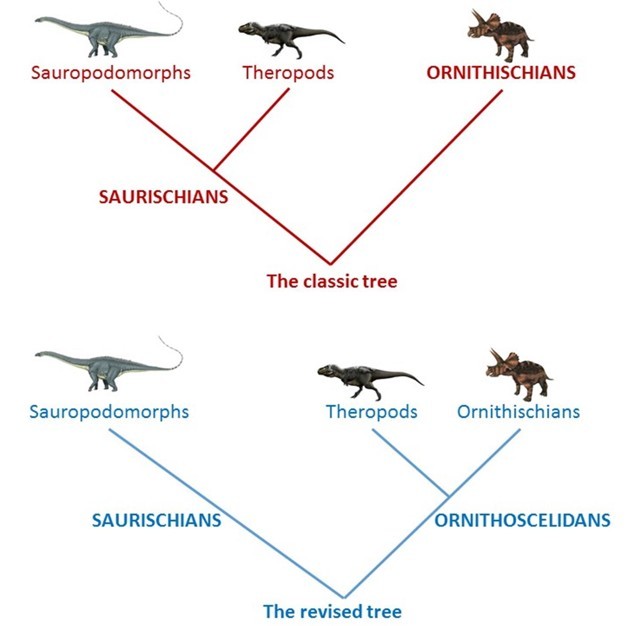The Chilesaurus diegosuarezi was first announced to the world in 2015, and its name appeared to tell us a lot about it. It was discovered in 2004 in Chile by a then-seven-year-old boy named Diego Suarez. But in truth, the Chilesaurus was one of the most mysterious dinosaurs ever found.
Not that it looked especially strange. It lived around 145 million years ago in the late Jurassic period. It could grow to about 3 m (10 ft.) long, and used the same bipedal (two-legged) walk of hundreds of other dinos. But despite its raptor-ish appearance, this was no meat-eater. Veggie chili only for this Chilesaurus, please and thank you! But where did this guy fit on the dinosaur family tree?
Well, after two years of research, paleontologists are ready to say where the Chilesaurus fits in dino evolution. As long as they can agree on how that evolution works. Allow us to explain...
Where do I fit?
Let's talk about the dinosaur world for a bit, where there are three major groups of animals.
"Long tails, long necks...we're the sauropods!" (Getty Embed)
Sauropods ("lizard feet") walked on four limbs, had thick bodies, and had long tails and necks. This group includes the largest dinosaurs to ever live, such as Argentinosaurus, Diplodicus, Brachiosaurus, and Apatosaurus.
"Did someone say 'lunch time'? Us theropods sure are hungry!" (Getty Embed)
Theropods ("wild beast foot") walked on two legs and were often carnivorous. They include large predators like Tyrannosaurus, smaller ones like Velociraptor, and omnivores like Oviraptor.
"Where's the buffet? Ornithischians are looking for our greens!" (Getty Embed)
Finally, there were the ornithischians ("bird-hipped"). These were mostly four-legged herbivores, and include some of the most common dinosaurs species, such as the armoured Stegosaurus and Ankylosaurus, the duck-billed Lambeosaurus, and the horned Triceratops.
So why are we talking about all of this? Because Chilesaurus was like a mixture of two of these groups: theropods and ornithischians. And that might be because it represents a time when these groups first split off from one another.
A first!
The fossil skeleton of the Chilesaurus. (Getty Embed)
Chilesaurus was first believed to be a small theropod. And yet it also had similar features to ornithischians. It was a little bit of both groups—like how a platypus looks caught between being a beaver and a duck. Scientists think that this unique profile is because Chilesaurus comes from a time when theropods and ornithischians were evolving from a common ancestor.
Chilesaurus was perhaps one of the first of its kind to begin to look to plants for food instead of meat. It might seem hard to picture, but this small animal might represent the moment in evolution when the dinosaurs that would become Triceratops broke away from Velociraptors. Whoa!
The changing tree?
What makes this discovery even more exciting is that it comes at a time when all dinosaur theory is starting to change. A three-year study led by Matthew Baron of the University of Cambridge was released this March. It says that the dinosaur family tree (which we've followed for 130 years) is wrong.
No, no, we're not going to make you read his study! Just the important stuff shown below...

The old dinosaur family tree (top) is being challenged by a new version, and Chilesaurus is an excellent argument for why it might be correct. (Creative Commons)
Do you see the difference? It's small, but have a look again.
In the classic tree, the sauropods and theropods belonged to a larger group called saurischians, while the ornithischians were all on their lonesome.
But in Baron's revision, its the sauropods that are the lonely branch, while the theropods and ornithischians come from the same wing.
And how does this relate to our buddy, Chilesaurus? Well, if Baron and his fellow researchers are correct, Chilesaurus would fit right in the area where both the theropods and ornithischians break off from each other.
Is Baron's theory seen as accepted fact? Not yet. Scientists always take their time coming to conclusions (good idea!). But there is no question that the arrival of Chilesaurus has helped turn our understanding of the dinosaur world topsy-turvy.
We wonder what Diego Suarez (who is now 20, by the way) thinks of all of this!
 A rare dinosaur that scientists think could be at the centre of an even bigger dinosaur discussion. (Gabriel Lio)
A rare dinosaur that scientists think could be at the centre of an even bigger dinosaur discussion. (Gabriel Lio)










😮 💡 🙂
😎
qaesxcdrftvijomnubyvd 5crtvdrfhtbgynhujimkjhbtfvydrfb6vtnyijm 😛